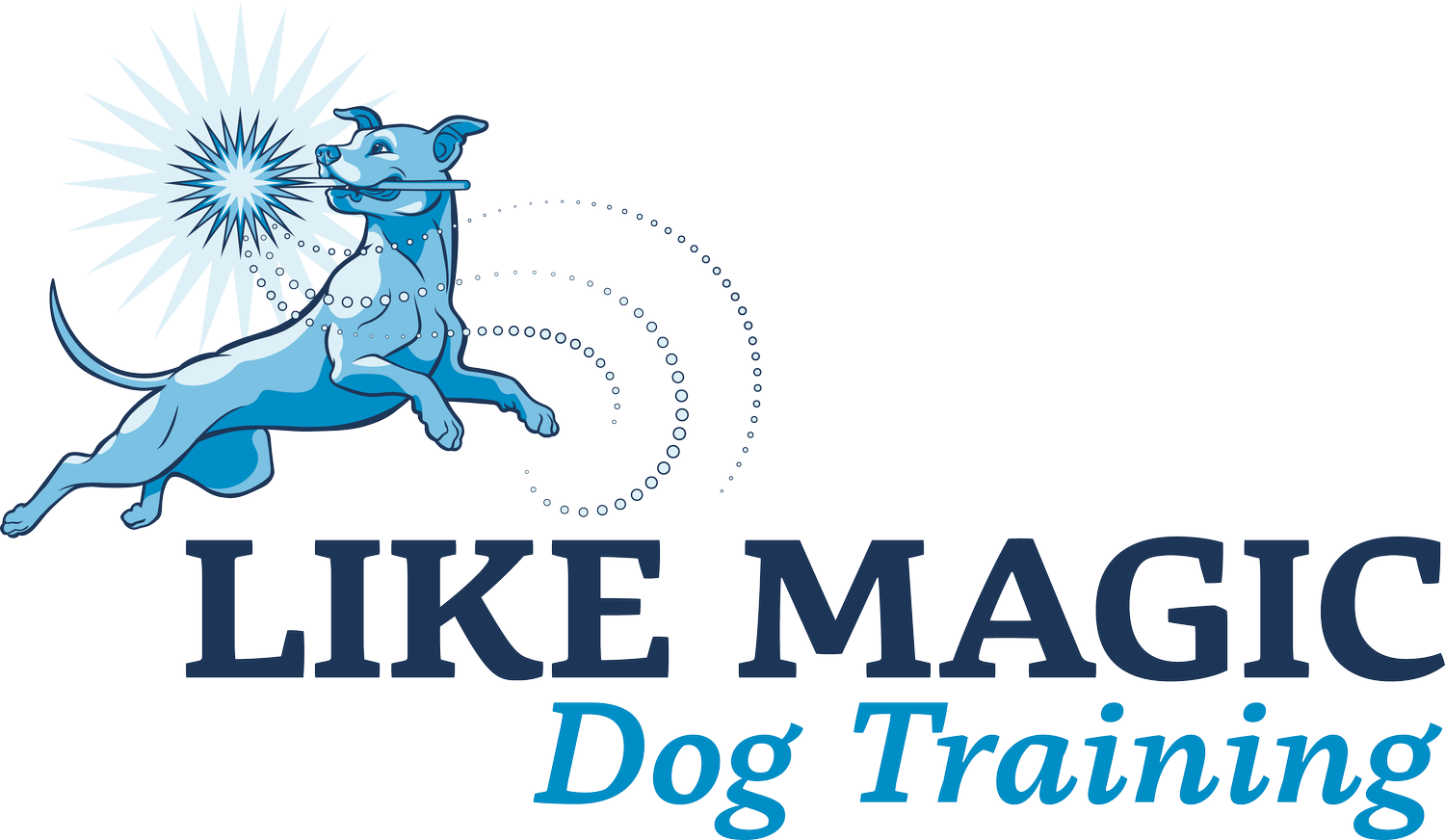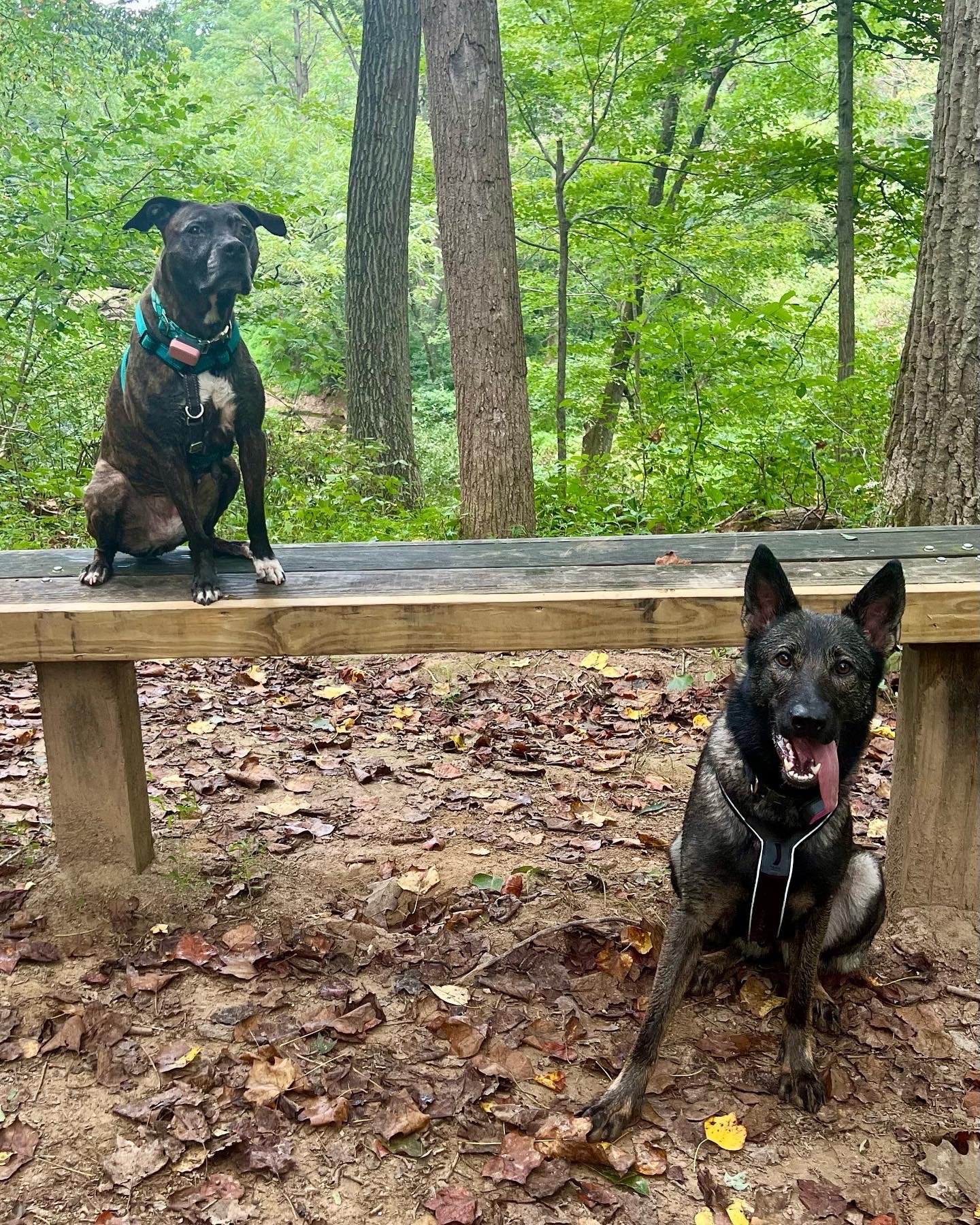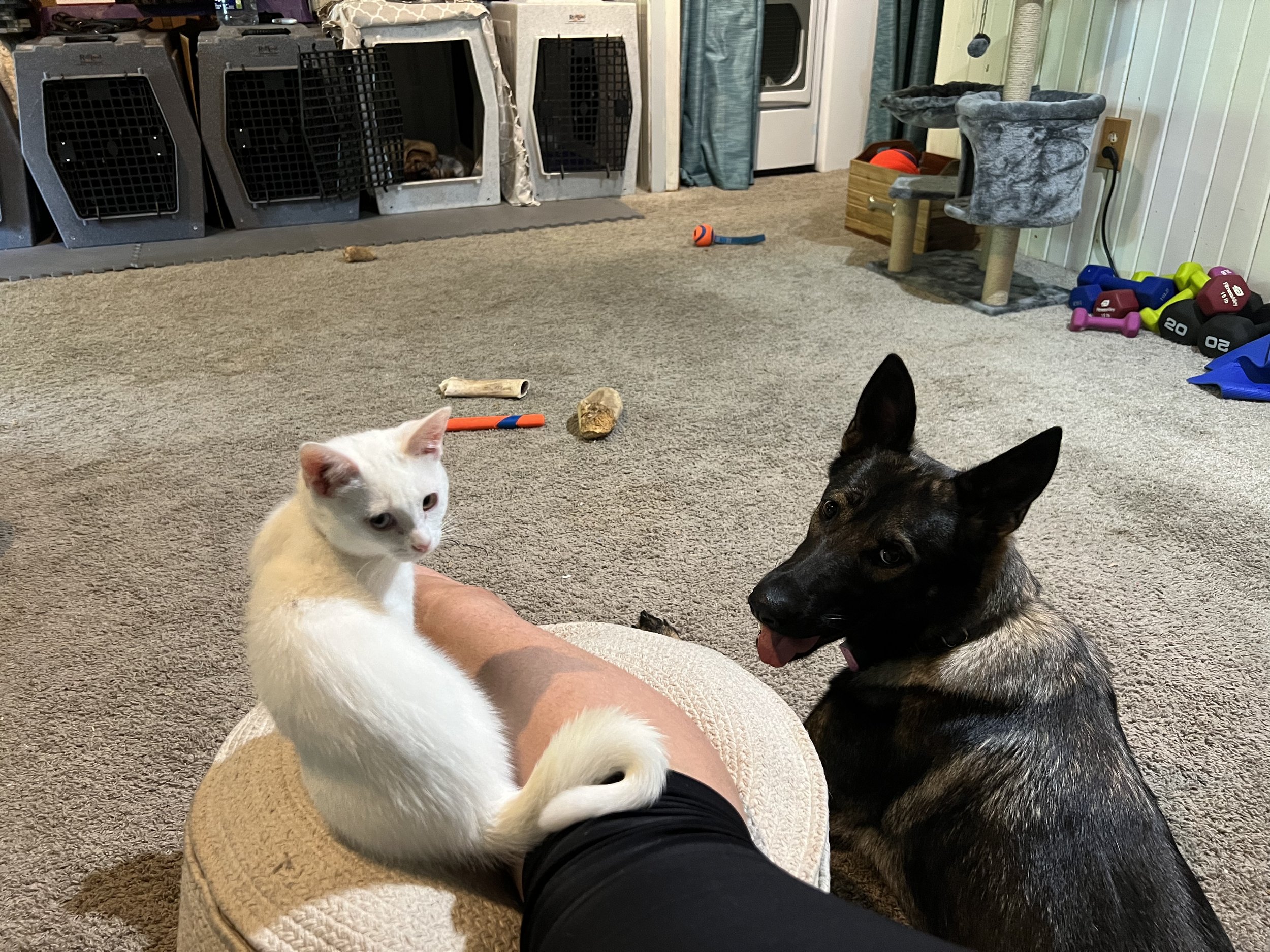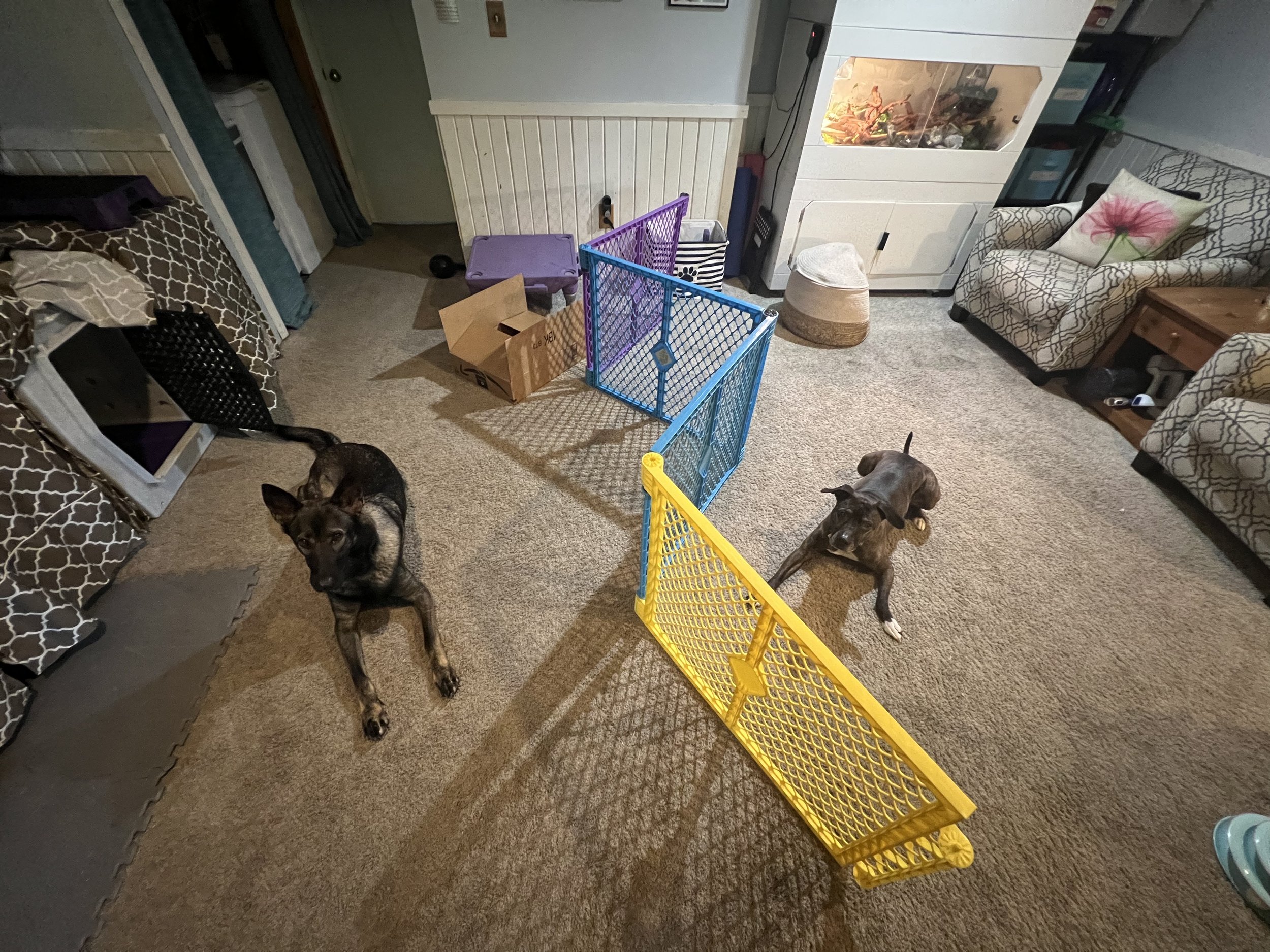The first question I get when discussing any of the new arrivals into my home is a polite, “Oh, and how is Mouse doing with that?”
Mouse, it is known, is a complicated dog. Or perhaps the problem is that she is far too straightforward. A classic pit bull, she struggles with arousal control around other animals, and has always been reactive towards dogs. It’s been rare that she has a dog friend, and never one for very long. Over the years, she’s adopted what I fondly refer to as a “don’t start nothing, won’t be nothing” philosophy, but her definition of “starting something” can be impressively subtle.
I knew that getting a second dog would be a Herculean task. For years, I wrote off the possibility, was content with Mouse being my one and only dog for the entirety of her life. Overall, we were quite happy with that. Even when I started training full time, I borrowed demo dogs as I needed them, and Mouse was good enough at being neutral that she could help in plenty of scenarios.
Then, the pandemic hit. Which is such a frequently used fulcrum for drastic changes at this point that it’s nearly a trope in and of itself. But I quickly learned that when I didn’t have the outlet of training other people’s dogs, I got pretty restless pretty quickly. I wanted to train. Mouse, the aging pittie who has an affinity for being left on her own in sunbeams…did not.
At least not as much as I wanted to. And I realized as I worked with her, and practiced behaviors with client dogs, that I felt distressingly stagnant. Starting over with familiar behaviors wasn’t challenging me, and it wasn’t making me a better trainer. Foundations are essential, and I love that I have the opportunity to practice them as much as I do. But to be mechanically challenged, I needed to start training new things and expanding my horizon. I needed another dog.
At this point it was something I had toyed with. Mouse had a small circle of dogs she hiked well nearby, even with a leash dropped. She had successfully had dogs stay in the house. She even befriended one particular absolute saint of a boarding dog. A second dog seemed…possible.
Preparation started with friends’ dogs. Spending more intentional time with one another. Muzzled off leash hikes and sniff spots. Relaxation sessions inside the house. More boarding and utilizing my space to make it two-dog friendly. Baby gates were identified and installed.
Fig arrived more quickly than we’d planned. But upon her arrival things still went slowly. Fig primarily lives in the basement, in my training office - out when I’m in the office and available to her, crated when I’m not. This works well for our dog-dog challenges, but also for Fig, who has a tendency to get into trouble when left unattended and loose. When crated, things started with a gate around the crate, then just a crate cover available when supervised, to where we are now - Fig and Mouse are prepared to ignore one another behind gates or crate doors. They rarely ever even sniff at each other, whether they are on either side of a baby gate, the back kennel, or their crates.
And that’s an important distinction. My goal in this was always to have two dogs who basically ignored one another. I have no illusions that Mouse wants a friend, or that Fig needs to be that friend. Fig is much more social, and has plenty of friends. Her sister, she needs to simply co-exist with. We’ve done that by parallel hikes, and then progressing to off leash parallel time - but first always with Fig and Mouse being given tasks to do (chase a ball and rest on a mat, respectively). Indoors we have done relaxation protocol with a barrier up. At this point, the barrier is almost completely down, but it will go back up when one dog is asked to perform tasks while the other holds their down.
Early on, Mouse and Fig practiced doing training sessions and relaxation on either side of a baby gate.
Outdoors now, they’ve been able to be walked by one person, pose for pictures, and co-exist without being given specific tasks. First with a muzzle, and then without as they proved themselves relatively uninterested in one another. The goal will be to continue building those habits outdoors so that by the time (if the time comes) they are asked to do the same indoors, they are well-versed at ignoring one another. I fully expect to be working on this over the next year, at least.
We’ve done similar with the kitten we recently adopted. Catra was an unexpected surprise, but we’ve followed similar protocol. Currently, our house is crate and rotated three ways. Catra remains in one of her rooms (unless she makes her way into the drop ceiling…), Fig is in the training room, and Mouse is elsewhere in the house. As we build comfort with sounds and smells of each other, we are setting up spaces in the house for Catra to be high up and hidden from the dogs if she should so choose. When they are together, we are working on relaxation and stationing behaviors while everyone is getting trained, for only a few moments at a time. Catra can be aggressive towards the dogs, and while Mouse is uncertain about that and Fig barely notices, it’s clearly from a place of fear. My goal is to continue to build Catra’s confidence and help her understand she always has options to access places the dogs aren’t permitted. For the dogs, my goal is for Catra to be barely something they notice.
It’s often a surprise to folks when they realize that my three (mammalian) pets have barely ever met, and almost never in the house they all three live in. It is, however, the way that we can ensure that all the pets involved feel safe and comfortable, and continue to do so as we help them understand how to live alongside one another. And if that takes some extra time to achieve that peace - that’s all good with me.
Practicing with close supervision Fig and Catra relaxing together with me. Fig isn’t aggressive about Catra, but does think she’d be really fun to play with, which just isn’t safe with their difference in sizes.
In both images with Catra, the dogs were being asked to lay down and relaxed while Catra had the opportunity to explore them. Now that Catra is a little more comfortable in the home, she’s also being asked to remain on her own station.
Early on, barriers spanned across the whole room while both dogs were tethered and as far apart from one another as they could get. Here you see the barrier is fairly short and they remain fairly close to one another. I was able to walk around them and do relaxation protocol exercises while they both held their downs.
Later, we moved them further apart again, but took away the barrier entirely. Both dogs didn’t move from their downs in an 8-10 minute session in the room with one another. There were also no hackles/barking/shifting that would indicate that either was approaching threshold.










